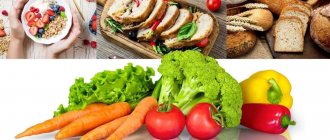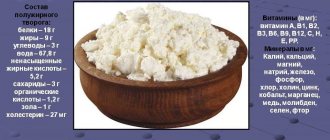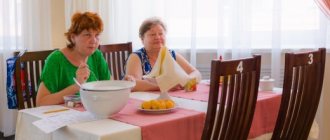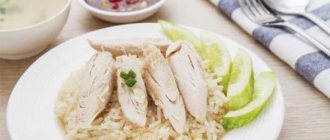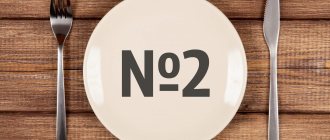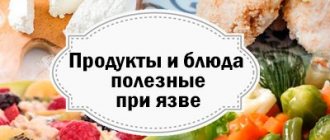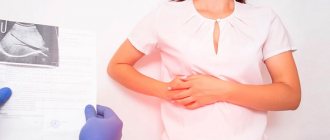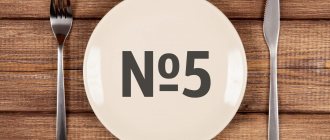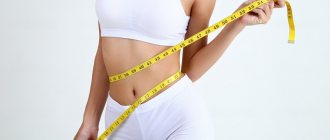The fifteenth diet is a balanced, healthy, complete diet. The diet belongs to a number of therapeutic nutrition systems developed by the Soviet scientist Manuil Pevzner. Using simple rules and requirements, this technique speeds up recovery from illness, improves immunity in adults and children, and normalizes weight. From time to time it is recommended even to healthy people for the prevention of diseases of the gastrointestinal tract, liver, kidneys, and heart.
Principles, rules and goals of medical diet table No. 15
Table 15 is a medical diet, the main principle of which is a complete and balanced diet without heavy and spicy foods.
Rules for preparing and eating dishes on this diet:
- eating 4-5 times a day (every 2-3 hours);
- there are no restrictions on the method of preparing dishes (you can fry them, but not in lard);
- lunch is 35-40% of the daily diet, dinner is 15% (no later than 2 hours before bedtime);
- serving size 250-300 g (2 palms);
- maximum salt intake – up to 15 g per day;
- it is necessary to drink 1-1.5 liters of liquid per day (before 16-00), preferably clean still water;
- Duration ranges from 3 to 6 weeks.
This therapeutic food is prescribed for hypertension. When preparing dishes for patients with high blood pressure, do not add salt, but add salt to the finished portion yourself (5-6 g of salt per day).
The purpose of prescribing this therapeutic diet is to provide patients with adequate nutrition during inpatient treatment, in medical resort complexes, and after discharge from the hospital at home.
Prohibited Products
The list of prohibited foods for diet No. 15 is not so long. Only preservatives, dyes, flavor and aroma enhancers, and foods that stimulate the central nervous system (coffee, strong green tea, rich meat and mushroom broths, fatty side dishes, spicy, too salty and sour) are excluded.
In order not to overload the stomach, you need to get rid of heavy animal fats: lard, lard, smoked meats, beef and lamb fat. It is better to boil or bake or steam lean meat. Fried foods should be kept to a minimum.
To avoid toxic effects on the body, you should completely avoid purchased crackers, snacks, chips, and peanuts with additives. Sweet sodas, packaged juices, kvass, and instant coffee are excluded.
For the duration of the diet, you need to give up store-bought sauces and hot spices. This includes: mustard, ketchup, mayonnaise, horseradish, Tabasco, turmeric, anise, etc. The use of trans fats is also not allowed, the most common of which is margarine. Avoid foods that contain hazardous cooking oils and additives.
A mandatory requirement for the diet is the abstinence of alcoholic beverages. The toxic and destructive effects of alcohol can completely neutralize the therapeutic effect of the diet.
Chemical composition and energy value of the diet
The calorie content of this diet is 2600-2700 kcal per day. The ratio of proteins, fats and carbohydrates should be 1:1:4.
Products should have the following nutrient content:
- proteins – 70-80 g (animals 50-55%);
- fats – 80-85 g (vegetable-30%);
- carbohydrates – 350-450 g.
The assortment of this diet must include fermented milk products, cereals and vegetables with a high fiber content.
Efficiency
Dietary table No. 15 has long proven its effectiveness; just 1 week of the proposed diet gives the following results:
- Normalization of digestive processes.
- Improving well-being after an illness.
- Positive dynamics in recovery from illness.
Indications for diet
Table 15 is a medical diet, which is prescribed by the attending physician when undergoing treatment in hospitals, sanatoriums or at home. For women
The diet is prescribed for women:
- 3-4 days after surgery;
- after a long strict diet;
- for a smooth transition to normal nutrition;
- to cleanse the body of waste and toxins;
- to improve immunity.
For pregnant and lactating women
This diet is prescribed to pregnant and lactating women for adequate nutrition with a limit on heavy and salty foods.
On the recommendation of the attending physician, additional vitamin and mineral complexes are prescribed; the number of meals and caloric content of foods may be increased, since the number of calories for pregnant women ranges from 2500 to 3200 kcal per day, for a nursing young mother - 3500 kcal.
For men
This therapeutic diet is prescribed for men when transitioning to a normal diet after strict therapeutic diets and 3-4 days after surgery. An averagely active adult man requires 2600-2800 kcal per day. Therefore, table 15 can be recommended for reducing and stabilizing weight in men.
For children
This food is recommended for children aged 3 to 15 years:
- after infectious diseases (measles, rubella, chickenpox);
- to improve immunity;
- after operations;
- for weight loss and stabilization in children from 11 to 15 years old.
After operation
This diet is prescribed after surgery 2-3 days later.
Table 15 diet. Sample menu
For diseases of the digestive system, table 15 can be used only after a year.
For gastritis
This therapeutic diet can be prescribed after treatment of gastritis and after a therapeutic diet (table No. 1 and No. 2) only after 6-8 months.
Application of the treatment program
Diet (table) No. 15 was compiled by Pevzner as a general technique for patients during the period of rehabilitation and recovery. In addition to this technique, the scientist compiled fourteen other, more strict diets, each of which is used for a particular pathology [1]. Table No. 15 is used before switching to a normal diet after more stringent food restrictions.
In sanatoriums, hospitals and resorts, this diet is recommended for people who do not require a special menu. A balanced and nutritious diet compensates for the lack of useful components, relieves stress on the digestive organs and cardiovascular system.
Content:
- Application of the treatment program
- Treatment program rules
- Products for diet
- Prohibited Products
- Wellness menu
- Diet 15g
- Results of a therapeutic diet
Diet No. 15 is used to prevent various diseases. A proper diet strengthens and improves the immune system, increases resistance to viruses, infectious and fungal diseases, so the body is better able to resist pathogens.
The calorie content of the diet is normal, so the treatment table can be prescribed for people who are prone to overeating and weight gain. Due to this technique, a smooth weight loss occurs without loss of useful components and starvation.
In addition, diet number 15 is prescribed after suffering stress, during periods of depression, and neuroses. The list of recommended products contains items that do not irritate the central nervous system and strengthen the nervous system due to magnesium, folic acid, and thiamine.
Menu for the week
When planning a menu, you should take into account the calorie content of ready-made dishes and use seasonal products.
Monday
- Breakfast: corn porridge baked with cheese, apple pie, milkshake.
- Dinner: soup with meatballs, mashed potatoes with sausage, vegetable salad, bread, tea.
- Afternoon snack: a handful of nuts, cocoa.
- Dinner: pollock baked with carrots and tomatoes, kefir.
Tuesday
- Breakfast: muffins with chicken and zucchini, sweet cottage cheese with strawberries, milkshake.
- Lunch: fish soup, spaghetti with tomato sauce and mozzarella, vegetable salad of cabbage and carrots, bread, herbal tea.
- Afternoon snack: pecan pie, apple juice.
- Dinner: baked eggplant with chicken, yogurt.
Wednesday
- Breakfast: buckwheat porridge, cinnamon pie, fruit juice.
- Lunch: rice tomato soup, veal stew with carrot puree, sweet bell pepper salad with tomatoes, rye bread, fruit juice.
- Afternoon snack: a glass of kefir or fermented baked milk with homemade crackers.
- Dinner: cabbage rolls, yogurt.
Thursday
- Breakfast: egg with sausage and tomatoes, cheesecake, berry smoothie.
- Lunch: vegetable soup with sour cream, rice with boiled veal, Greek salad, cappuccino.
- Afternoon snack: cottage cheese pie, yogurt.
- Dinner: baked meatballs with buckwheat, cucumber salad, kefir.
Friday
- Breakfast: pumpkin pie, cottage cheese and poppy seeds, a glass of yogurt.
- Lunch: creamy pea soup with semolina dumplings, homemade pizza with sausages and cheese, fruit juice.
- Afternoon snack: cheesecake, cocoa.
- Dinner: sweet rice porridge, compote.
Saturday
- Breakfast: oatmeal with nuts, sweet crackers, milk berry smoothie.
- Lunch: cabbage soup, sausages with carrot puree, baked tomatoes with egg, compote.
- Afternoon snack: pumpkin pie, compote.
- Dinner: beef stroganoff with pasta, vegetable salad, yogurt.
Sunday
- Breakfast: corn porridge with raspberries, pie with curd and banana filling, cocoa.
- Lunch: soup with turkey meatballs and vegetables, chicken drumsticks baked with cream and rice, Olivier salad with homemade mayonnaise, fruit drink.
- Afternoon snack: snack muffins with chicken and broccoli, compote.
- Dinner: fried fish with pumpkin puree, vegetable salad, kefir.
How to cook?
Almost the only restriction on cooking applies to fried foods, because the amount of cholesterol and trans fats contained in them can cause serious problems with the heart and blood vessels. Therefore, any person who wants to be healthy (not necessarily dieting table number 15) is obliged, if not to exclude, then to minimize the consumption of fried foods.
There can be many ways of cooking: stewing, boiling, steaming. Most often, it is better to use a combination of vegetables, meat and fish in stewed form. These are fairly easy to prepare recipes that are also not difficult to prepare. The diet also allows for the preparation of pancakes, cheesecakes and similar products, but you should not abuse it!
Menu for children
At a table of 15 for children, the calorie content of dishes is 2600-2700 kcal. The number of meals is increased to 5 times a day. In this therapeutic diet for children, it is worth reducing the amount of sugar and simple carbohydrates (pasta, white bread), and introducing complex carbohydrates (products made from wholemeal flour) into the diet.
It is worth increasing the amount of protein (more dairy products), vitamins and microelements (juices, decoctions) . Diversify the assortment of first courses, prepare cream soups with vegetables, green peas, crackers.
Try to cook porridge with milk, add seasonal fruits, nuts, honey. For drinks, prepare fruit drinks, compotes from seasonal berries and fruits. Curd jellies and puddings with fruit are suitable for an afternoon snack.
- Breakfast at 8-00: oatmeal with milk and honey, fruit salad, cheesecake and cocoa.
- Breakfast at 11-00: cottage cheese with berry jelly, smoothie.
- Lunch at 14-00: chicken broth with carrots and curly noodles, veal goulash with mashed potatoes and cauliflower, tomato and cucumber salad, bread, tea.
- Afternoon snack at 16-30: bun with nut filling, yogurt.
- Dinner at 19-00: omelette with vegetables, milkshake.
Calorie distribution
Dietary table No. 15 also includes the consumption of high-calorie foods, but the distribution of calories during one day should occur as follows:
- 20% reserved for the morning meal.
- 10% It is recommended during a snack, which is taken between breakfast and lunch.
- Lunch is the most satisfying meal, accounting for 35% of all daily calories.
- The afternoon snack corresponds in caloric content to a snack after breakfast; 10% of the daily calorie intake is allocated to it.
- During dinner, 20% of the daily calorie intake is consumed.
- is allowed , which is taken shortly before bedtime; it can include no more than 5% of all calories consumed per day.
If the patient has been diagnosed with stage 1 or 2 hypertension, then the diet involves preparing food without salt, but it can be given to the patient in an amount of no more than 7 grams. In this case, a person gets the opportunity to salt his food on his own, distributing the amount of salt allotted to him throughout the day.
Recipes for dietary dishes for adults and children
Table 15 is a medical diet that uses simple dishes.
Milk noodles
Energy value per 100 g 83 kcal, proteins 3.6 g, fats 2.7 g, carbohydrates 11.1 g.
To prepare 2 servings you need:
- milk 250 ml;
- water 100 ml;
- noodles 55g;
- salt and sugar to taste.
How to cook:
- Pour milk and water into a saucepan with a thick bottom, put on fire and add salt to taste.
- After boiling, add noodles to the pan and stir constantly for the first 2-3 minutes.
- Cook milk noodles for 8-10 minutes.
- Turn off the heat and leave the noodles covered for 5 minutes.
- Add sugar to taste to the finished dish.
Milk noodles are suitable for children and adults for breakfast, lunch or dinner.
Baked pumpkin
Energy value 100 g 44.9 kcal, proteins 1.6 g, fats 0.3 g, carbohydrates 8.9 g.
The calorie content of the dish will increase if you sprinkle sugar or honey on the prepared pumpkin.
To prepare 4 servings you need:
- sweet pumpkin 600 g;
- water 150 ml.
How to cook:
- Peel the sweet pumpkin from seeds and peel.
- Cut the pumpkin into small pieces.
- Turn the oven on at 190⁰.
- Place the pumpkin in a baking dish, add boiled water to cover by 4-5 mm.
- Bake in the oven for 30-40 minutes. at a temperature of 190⁰-200⁰, depending on the type of pumpkin and the size of the cut portions. No need to cover with foil or parchment.
Baked pumpkin can be eaten for breakfast, lunch or dinner for children and adults.
Chicken cutlets
Energy value 100g 144 kcal, proteins 16.2 g, fats 3.5 g, carbohydrates 11 g.
To prepare 4 servings you need:
- chicken fillet 500 g;
- egg 1 pc.;
- white bread 150 g;
- milk 100 ml;
- salt to taste;
- greenery.
How to cook:
- Soak white bread in milk.
- Cut the chicken fillet into small pieces and pass through a meat grinder 2 times.
- Mix minced chicken with egg, salt, add bread squeezed out of milk.
- With wet hands, form small cutlets.
- Turn on the oven at 180⁰.
- Place chicken cutlets on a baking sheet lined with parchment paper (or in a fireproof pan greased with vegetable oil).
- Bake the cutlets for 25-30 minutes. at a temperature of 180⁰С.
- Decorate the finished cutlets with herbs.
Chicken cutlets are suitable for children as a second course for lunch or dinner.
Zucchini muffins with chicken
Energy value 100 g 161 kcal, proteins 9.3 g, fats 10.5 g, carbohydrates 6.9 g.
Required Products:
- chicken fillet 200-250 g;
- small zucchini 400-500 g;
- 2 eggs;
- flour 2 tbsp;
- unsalted cheese 100 g;
- herbs and salt to taste.
How to cook:
- In salted water for 15-20 minutes. boil the fillet.
- Peel the zucchini, grate it on a coarse grater and add salt. After 3-5 minutes. drain off excess liquid.
- Cut the chilled chicken fillet into small cubes.
- Add eggs, chopped herbs, and chicken fillet to the zucchini.
- Add flour to the zucchini-meat mass, add salt to taste and mix thoroughly.
- Preheat the oven to 180⁰.
- Place the zucchini mixture into muffin tins greased with vegetable oil (do not grease silicone molds).
- Bake the cupcakes for 15-25 minutes. You can sprinkle with grated cheese in 3-4 minutes. until ready.
Muffins with zucchini and chicken are suitable as a dinner or snack for children and adults.
Buckwheat porridge with eggs and herbs
Energy value 100 g 120 kcal, amount of protein 1 g, fat 7 g, carbohydrates 25 g.
To prepare 2 servings you need:
- 100 g buckwheat;
- 150 ml water;
- 2 eggs;
- 10 g butter;
- greens (dill, parsley);
- salt.
How to cook:
- Sort out the buckwheat and fry in a frying pan without oil for 4-5 minutes.
- Boil the eggs for 7-8 minutes.
- Pour the fried buckwheat into a saucepan, add water, salt and cook for 10-15 minutes.
- Finely chop the boiled eggs and herbs.
- Add butter, eggs and herbs to the hot porridge.
Buckwheat porridge with eggs and herbs is suitable as a breakfast and main course for adults and children.
Cauliflower and Broccoli Casserole
Energy value 100 g 74 kcal, proteins 4.8 g, fats 4.2 g, carbohydrates 4.4 g.
To prepare 4 servings you need:
- cauliflower 350-400 g;
- broccoli 350-400 g;
- eggs 3 pcs.;
- cream 10% 100 ml;
- salt to taste.
How to cook:
- Boil the cauliflower and broccoli in salted boiling water for 3-4 minutes.
- Salt the eggs and cream and beat with a mixer or fork.
- Turn on the oven at 190⁰.
- Layer cauliflower and broccoli florets in a greased baking dish.
- Pour the egg-cream mixture over the cabbage.
- Place the casserole dish in the oven and cook for 20-25 minutes. until a golden brown crust forms.
Cauliflower and broccoli casserole is suitable as a second course for lunch or dinner for adults and children.
Millet porridge with cottage cheese
Energy value 100 g 159 kcal, proteins 6 g, fats 2 g, carbohydrates 29 g.
To prepare 2 servings you need:
- millet cereal ½ cup;
- water 350-400 ml;
- cottage cheese 100-150 g;
- sugar to taste.
How to cook:
- Rinse millet cereals thoroughly in running water (until the flowing water is transparent).
- Pour water over the cereal, add salt and cook for 15-17 minutes. after boiling until done over low heat. You can use a thick-bottomed pan to prevent the porridge from burning.
- Grind the cottage cheese through a sieve and add sugar.
- Add sweet cottage cheese to the prepared hot porridge and stir.
Millet porridge with cottage cheese is suitable for adults and children for breakfast and dinner.
Baked tomatoes with egg
Energy value 100 g 67 kcal, proteins 4.7 g, fats 3.9 g, carbohydrates 3 g.
To prepare 6 servings you need:
- 6 medium tomatoes;
- 6 eggs;
- greenery;
- salt to taste.
How to cook:
- Wash the tomatoes and cut off the top with a knife. Using a teaspoon, scoop out the tomato pulp.
- Wash and chop any greens.
- Place parchment paper in a baking dish and add tomatoes.
- Pour an egg into each tomato, add salt and sprinkle with herbs.
- Bake tomatoes in the oven at 180⁰ for 25-30 minutes.
Baked tomatoes with eggs can be served as a hot or cold snack for adults and children.
Corn porridge with milk
Energy value 100 g 120 kcal, proteins 3.5 g, fats 4.8 g, carbohydrates 16 g.
To prepare 4 servings you need:
- corn grits 100 g;
- milk 300-350 ml;
- butter 10-15 g;
- sugar 10-15 g.
How to cook:
- Pour and heat milk into a saucepan with a thick bottom, add sugar.
- Next, gradually add corn grits into the boiling milk.
- You need to cook the porridge, stirring constantly, for 15-20 minutes.
- At the end of cooking, add butter to the dish, cover with a lid and leave to swell for 5-10 minutes.
Corn porridge with milk is suitable for adults and children for breakfast or as a second course for lunch.
Reviews
Elizaveta, 28 years old: “After a serious operation, I lay in the hospital for a long time, ate according to therapeutic diet No. 15, but at that time I did not yet know its name. My health has completely returned to normal, now I eat without restrictions, so I think that this course has benefited my body.”
Alexander, 32 years old: “I follow this diet even in the absence of any acute diseases at the moment. The reason is simple, this diet is very healthy, it allows you to split your meals into 5-6 times during the day, and the foods included in it are healthy. I practice this to keep my body in good shape and am pleased with the result.”
Margarita, 24 years old: “Doctors recommended this diet after a serious illness, I think that such nutrition can be very helpful in losing weight. At least I’ve never been overweight, but while on diet No. 15 I lost a few kilograms and had plenty of energy.”
List of prohibited ingredients
Despite the absence of radical food restrictions, it is necessary to completely exclude heavy, difficult to digest, spicy, smoked and fatty foods from the diet. Foods and drinks containing large amounts of chemical additives and dyes are also prohibited. The volume of sausage products consumed should be limited as much as possible. Duck meat, pork, lamb, lard, and goose meat are excluded from the diet. Before preparing poultry dishes, the skin from the carcasses must be completely removed.
Patients who are forced to follow dietary table No. 15 are recommended to avoid eating meat, fish and vegetable ingredients cooked on the grill and grill. The list of prohibited products includes ketchup, mayonnaise, store-bought salad dressings and various marinades. A complete avoidance of fast food, store-bought convenience foods, sweet drinks with added carbon dioxide, energy drinks, chips and snacks, as well as juices in cardboard and plastic packaging helps reduce the load on the digestive system.
